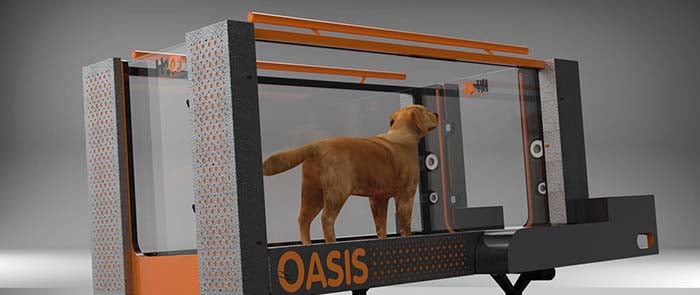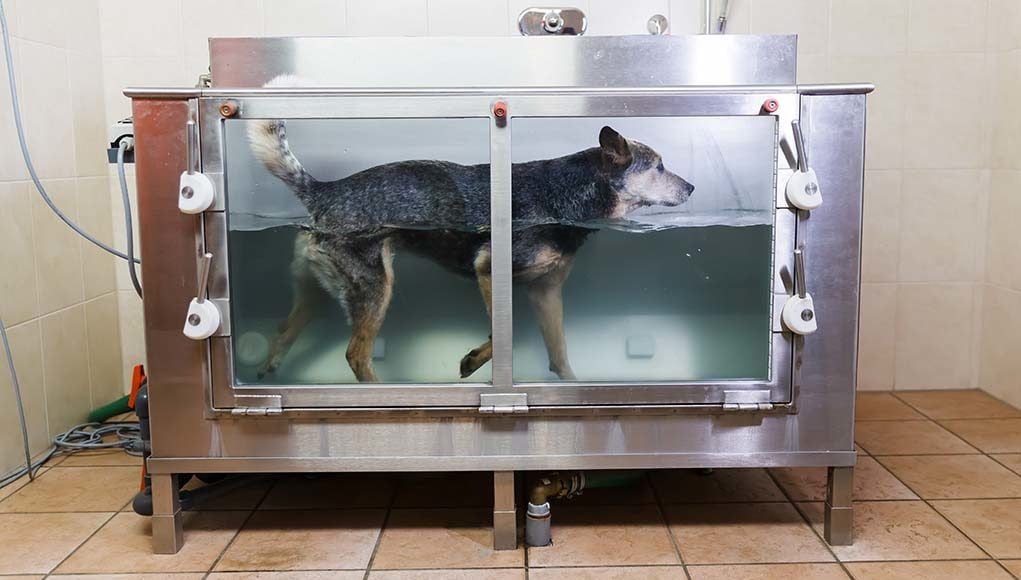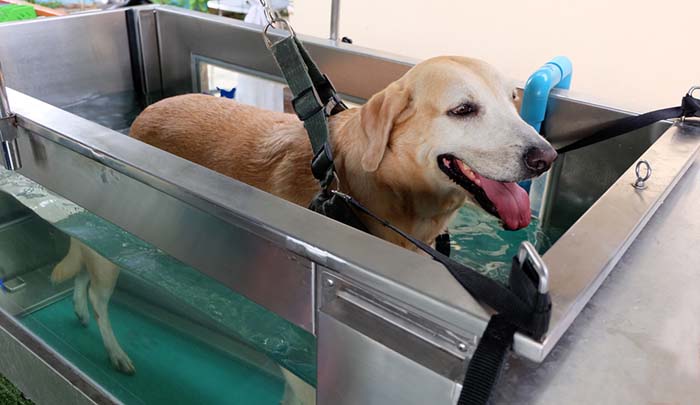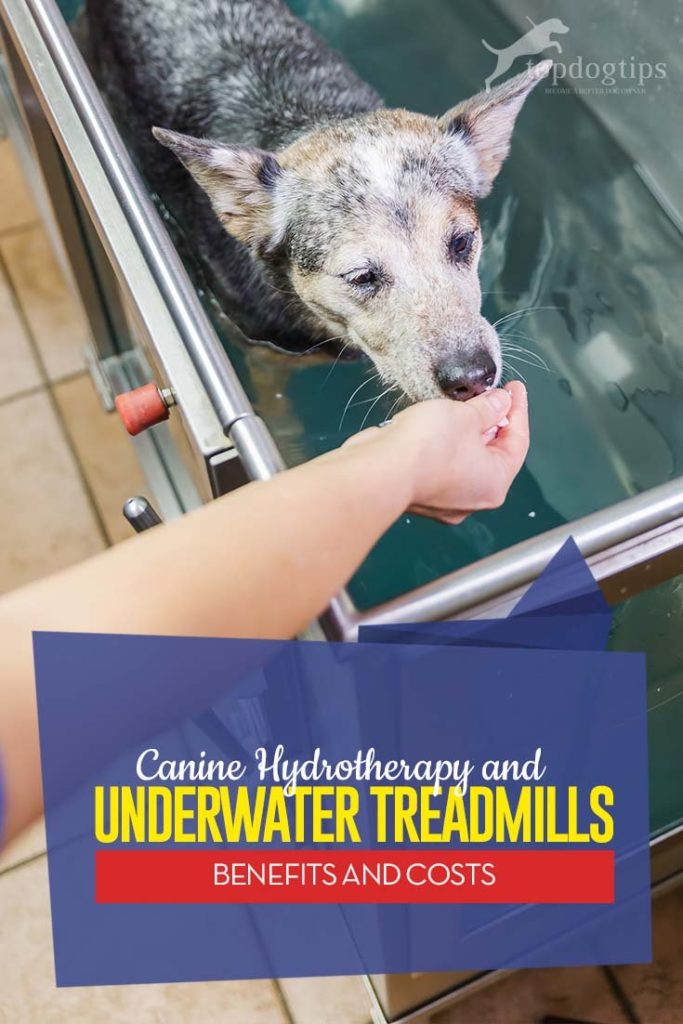Hydrotherapy for dogs is becoming more common in the pet industry.
Its rise in popularity in the industry is because of its success in human physiotherapy and recovery.
The veterinary industry evolved to help dogs on multiple fronts:
- Obese dogs lose weight
- Gently rehabilitate injured and arthritic dogs
- Provide a fun activity that keeps senior dogs' joints strong.
It's been proven that swimming can help with arthritis, and recent studies demonstrated the same with osteoarthritic dogs.
Several studies have also been done on the benefits of hydrotherapy for dogs.
For example, a 2011 study showed that hydrotherapy not only helps with OA but also helps dogs with cranial cruciate ligament and hip dysplasia.
Other studies showed positive results for canine elbow dysplasia and improvements in gait and range of motion among healthy dogs.
Another 2011 study with 13 obese dogs showed how an exercise regime using underwater dog treadmills was particularly helpful for safe weight management.
An underwater treadmill for dogs is the most popular type of hydrotherapy.
This therapy is great if you want to start working on preventative care with your pet.
You can use it to help keep your dog in shape.
Hydrotherapy also helps dogs recover from an injury or deal with arthritis.
And in this article, I will go over some things you should know about underwater dog treadmills.
Water Treadmill For Dogs: Pros and Cons
Getting Old is Painful
Our dogs go through the same physical deterioration that we do over time.
Their sight gets a little worse, they get winded faster during fetch, and their joints start to ache.
It happens much faster for pets, so veterinarians prescribe supplements like glucosamine chondroitin and various exercise routines.
Dietary changes and supplements alone aren't always enough, and what a stiff senior pup truly needs is an opportunity to stretch its legs without adding insult to injury.
This is where swimming in a pool or big bathtub and underwater animal treadmills come in.
The soothing flow of the water provides resistance that can be increased or decreased manually.
The fluidity allows your pup to move with less effort as its legs float through the water.
The buoyancy also takes their torso's weight off the elbows, hips, and ankles.
They're a Good Tool for Athletic Dogs
Athletic canines that are competitive in agility, strength, and other dog sports need extensive physical therapy to keep their bodies sound.
You've probably seen how NFL players, long-distance runners, and triathletes like to sit in a bucket of freezing cold water with ice after an event.
It helps to reduce inflammation and the absorption of lactic acid in their muscles; basically, it keeps them from becoming sore.
Since you obviously can't put a dog in an ice bath without a great deal of distress, underwater treadmills are the next best thing.
After pulling tires around, racing, or herding cattle, athletic dogs who require daily work also need daily recovery.
Even a slow, easygoing walk through the water to stretch the hips and thighs makes an underwater treadmill helpful to pups who struggle with hip dysplasia or similarly related health issues.
Alternative Hydrotherapy
Although it's highly recommended and has made life easier for hundreds of dogs, canine underwater treadmills may not be the right option for every pet.
Like anything else, this therapy device has its pros and cons.
One is that a fearful pup might refuse to move forward or move at all once the conveyor belt starts to rotate under its feet.
Some owners use flotation devices such as life jackets, allowing their dogs to move freely through the pool and giving them more confidence.
This way, there's less force involved, and your canine can move at their own pace and comfort.
While this method won't help maintain muscle mass as your dog ages, it'll still help with sore knees and stiff hips.
Pool therapy for dogs is also a little less costly at $20 to $30 a session.
How Much is Water Treadmill Therapy?
While an underwater treadmill type of hydrotherapy offers profound benefits, it usually costs a little more than just taking your dog to the beach, lake, or doggy pool.
Don't let this deter you from trying it out, though, as there are a couple of options available to owners who are still a little wary about using an underwater treadmill for dogs.
The first option would be to go to a specialized animal rehab facility and see if they offer any specials or trial periods for new clients.
Usually, when implementing a new technique for rehab, a specialist will ask you questions about your pup.
They'll most likely ask for veterinary records to reference and advise you on what should be done from there.
Most clinics offer aquatic treadmill therapy for dogs, starting at around $50 to $100.
For example, here are a few animal rehab clinics that offer it:
- Tsavo's Canine Rehab (California): $50 per 30-min session, treadmill
- Hydrotherapy Rehab Centre (Ireland): €35.00 per 30-minute session, treadmill
- CRCG (Colorado): $15-30 per 1-hour session, pool swim
Note: some places may require to pay for initial rehab consultation ($100-200) before the dog can undertake hydrotherapy treatment.
Water Therapy For Dogs At Home: Buy One for Your Home
Purchasing your dog's underwater treadmill would cost quite more upfront, along with the cost of repairs and maintenance.
In comparison, though, you'd save quite a bit of money on appointments.
You'd likely be able to work with your dog more often since you wouldn't be paying out of pocket every single time you turn it on.
The initial price of your treadmill could be anywhere from $1000 to $2500 plus, depending on the features included.
The genuine concern for pricing is the amount of water and electricity you'll be using regularly and cleaning it out often.
Some of the more popular sellers of canine hydrotherapy treadmills are:

As you can see, buying your own underwater dog treadmill is expensive for most pet owners or doesn't make sense in most cases.
And if you feel it would use too much power for your home, paying for a rehab facility a few times a week might work out better in your favor.
Some places also accept pet insurance, so ask when you schedule a consultation for your pup.
Hydro Treadmill for Dogs: Tips Before Going
Wash Your Dog
While you don't need to wash your dog every time you use it, they should be relatively clean before getting in the water at the animal rehab place.
If necessary, rinse their paws off before they get into the chamber.
Make Sure They've Relieved Themselves Prior
Additionally, ensure they've used the restroom within the last couple of hours; it's probably better to take them one more time before their physical therapy session.
If your dog does poop in the chamber at a facility, they may charge extra for the cleaning.
When they're finished, your dog might be thirsty after taste-testing the chlorine.
Be sure they're well hydrated before and after therapy.
If your pup pees, it's not as big of a deal because urine is much easier to clean than fecal matter floating under the moving parts of an aquatic treadmill.
Underwater Treadmill For Dogs: Summary
If your Fido needs hydrotherapy, try a few sessions at an animal rehab facility before you start looking on your own for an underwater treadmill.
Unless you want to try water therapy for dogs at home and buy your own. It's more convenient, granted you can afford one and spend time ensuring it's sanitary.
Also, check with your veterinarian beforehand to find the best water treadmills for dogs around.
They can usually give you a referral or recommendation to a reliable location with experienced staff and make sound recommendations on buying one yourself.
READ NEXT: Muscle Atrophy in Dogs – Causes, Prevention and Treatments
















